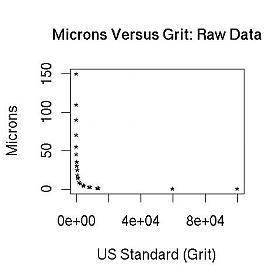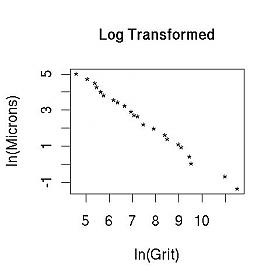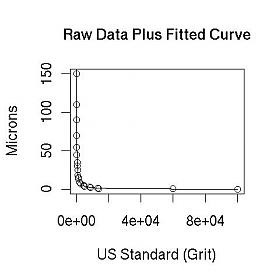Results 1 to 10 of 20
Hybrid View
-
04-19-2008, 07:03 PM #1Member

- Join Date
- Mar 2008
- Posts
- 77
Thanked: 11 Grit to mesh to micron conversion
Grit to mesh to micron conversion
I don't know if this has been posted before, or even if it's interesting. But I found a conversion chart for grits and microns (and meshes, whatever those are).
http://www.faceters.com/askjeff/answer67.shtml
To my understanding, hones are measured in grits, while pastes are measured in microns. This chart helped me see the connection. Maybe it will do someone else some good too.
Maybe it will do someone else some good too. 
-
The Following 2 Users Say Thank You to HenrikWL For This Useful Post:
niftyshaving (12-28-2009), tinkersd (09-26-2011)
-
04-19-2008, 09:04 PM #2

Mesh is usually used with diamond hones.
No matter how many men you kill you can't kill your successor-Emperor Nero
-
04-19-2008, 11:09 PM #3There is no charge for Awesomeness



- Join Date
- Aug 2006
- Location
- Maleny, Australia
- Posts
- 7,977
- Blog Entries
- 3
Thanked: 1587
Based on that chart, and assuming the data it contained was not rounded or approximated too much (maybe a big assumption, and there's some evidence that it has been to some extent), I just quickly ran a quick analysis to get a functional form for the relationship between grit and microns.
A graph of the raw data shows an exponential relationship (decay):

This is confirmed by the almost linear relationship when the natural logarithm of each variable is taken:

Treating the numbers in the table as data, and assuming a functional form between Microns and Grit of
Microns = C x Grit^B
(and including "measurement" error), the relationship between Microns and Grit is estimated to be:
Estimated Microns = 11764.71 x Grit^(-0.93589)
with approximate 95% Confidence intervals of (9146.074, 15133.100) for C and (-0.969, -0.903) for B.
This estimated relationship fits the original data quite well (original data are the points, the estimated relationship is the line):

The fidelity of the estimated relationship breaks down a little for higher grits. This is most likely due to increased rounding or approximation in, and sparsity of, the original data at higher grits. Note also that this is a local approximation - this relationship may not hold at grits outside the range of those included in the table.
So, if you had a Shapton 16k ceramic on glass and you wanted to know its grit, using the formula above you get:
Estimated Microns = 11764.71 x 16000^(-0.93589) = 1.37
Of course, a prediction error or confidence interval should accompany this estimate. A very approximate 95% confidence interval is (0.78, 2.41).
A little bit of maths can convert the formula into one that predicts grit if you know the Micron rating:
Grit = (Microns/11764.71)^-1.0685
So, using this one, a 0.92 micron hone is predicted to have a grit of 24440.42, with an approximate 95%CI for the prediction of (13404.45, 46542.28).
More data, accurately measured, would yield formulae with more precise (and accurate) estimates.
James.<This signature intentionally left blank>
-
04-19-2008, 11:23 PM #4
-
04-21-2008, 01:42 AM #5There is no charge for Awesomeness



- Join Date
- Aug 2006
- Location
- Maleny, Australia
- Posts
- 7,977
- Blog Entries
- 3
Thanked: 1587
OK, OK. I actually found some data from another source that includes some Shapton derived micron measurements. I couldn't find the formula that Shapton used, but as a quick and dirty attempt to reproduce the equation I ran a similar analysis as the one above on the new data.
The results were:
Estimated Microns = 14755.41 x Grit^(-1.00044)
(If anyone wants the confidence intervals so they can work out the prediction error, let me know )
)
This one just looks like a simple inverse relationship, which I guess makes physical sense. Does anyone know the Micron measurement of a grit of 1? Depends on the makeup of the grit, I suppose - based on the data, it looks like 1 Grit = 14755 microns in this case. So a simpler approximate formula is
Estimated Microns = 14755/Grit.
Anyway, with this data the Shapton-based microns work out better (16K = 0.918 microns), but the Norton-based micron calculations are a bit screwed (8k = 1.84 microns).
Again, if you want to predict Grit using known Micron values, you can use this one based on the simplified formula:
Estimated Grit = 14755/Microns
So, e.g., 0.5 micron Chromium Oxide power is predicted to be 29510 grit (approx. 30k) using this formula.
James.<This signature intentionally left blank>
-
04-21-2008, 01:49 AM #6

Well, atleast you didn't blow your day reading strange posts.
-
04-21-2008, 01:54 AM #7
-
02-07-2011, 09:20 PM #8Senior Member

- Join Date
- Apr 2010
- Location
- Central MA
- Posts
- 118
Thanked: 19
It's just a nomenclature thing. A 325-mesh sieve in the standard US Sieve Series and Tyler Mesh Series (used in the geo- and material sciences, etc.), for example, will screen out particles larger than ~45 micron. This link lists that same 45 micron size as being '40-50 mesh' (??) and it's 'hone equivalent' as 325-grit. Just a different classification scheme....
Last edited by Woodash; 02-07-2011 at 09:30 PM.
-
02-07-2011, 11:53 PM #9

Yes....
And in the world there are multiple classification schemes.
Because there are multiple international standards a Japanese 10K
and an American (US/ISO) 10K hone will differ.
One web site reports"
"15Ám Silicon Carbide(SiC) Film - This abrasive is an equivalent of 1200 Grit US,
or 1000 grit in Japanese Whetstone grit classification."
Some makers report the average grain size and others report
the maximum grain size.
For the most part grit finer than 1000 fall off the bottom end
of grit standards and are best thought of as vendor standards
not international standard. This lack of standards for
fine hones confuses some folk.
For this reason it can pay to purchase hones all from
one manufacturer or take a lot of time and research
the topic (or luck).
As others noted the material in the hone is important.
Some vendors transition from one abrasive to another
abrasive compound because in their experience and
their customer feedback guides them to it for specific
grits. CrO, SiO, Al2O3, Diamond, Garnet, Ceramic,
Al2(SiO3)3, boron nitride, numerous carbides etc. all
act a bit differently.
The sponsors of this site often have "sets" of hones.
These value packs make a lot of sense.


 4Likes
4Likes LinkBack URL
LinkBack URL About LinkBacks
About LinkBacks






 Reply With Quote
Reply With Quote





